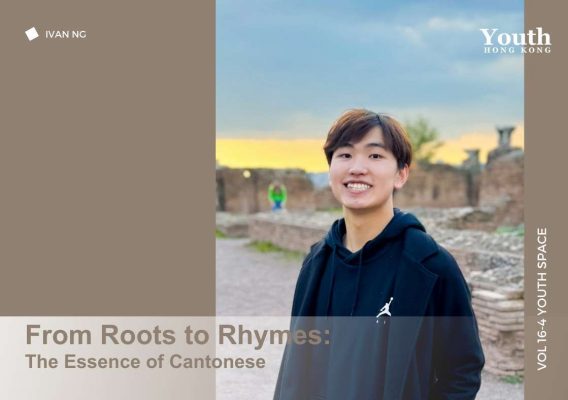//16.4 Youth Space: Language
by Ivan Ng
Ivan shares his understanding and passion for Cantonese, with its unique blend of Chinese and English influences.
What does Cantonese mean to you?
Growing up as a native Cantonese speaker, the language will always hold a special place in my heart. Together with Putonghua and English, Cantonese has shaped Hong Kong’s unique language policy – biliteracy and trilingualism. While many may see them as three separate languages, I regard them as an exceptional set of languages that heavily influence each other, especially in the context of Hong Kong.
For example, because Cantonese and Putonghua are both variants of Chinese, learning both help me to learn the Chinese language as a whole. Furthermore, knowing Cantonese makes the process of learning English much more interesting as an enormous quantity of Cantonese words and idioms have been influenced by English, such as “strawberry” (si6 do1 be1 lei2), “argue” (aau3 giu6), “taxi” (dik1 si2). Despite having different roots, English and Cantonese have an interinfluence on each other in Hong Kong, again highlighting the importance of Cantonese in shaping trilingualism in Hong Kong.
Despite its importance, unfortunately, Cantonese is less spoken in Hong Kong nowadays. According to HK01, a local online news portal, the percentage of people with Cantonese as their most commonly used language in Hong Kong has dropped by 2.8% compared to 2006; the percentage of people able to speak Cantonese also dropped at a similar rate, by 2.6%. Conversely, the percentage of people with Putonghua and English as their most commonly used languages has risen by 1.4% and 1.8%, respectively.
The phenomenon may be attributed to growing globalisation in the last two decades, which encourages the use of more “useful” languages such as Putonghua or English.
“It is more useful to teach my children Putonghua and English. I wish they could communicate with people from more diverse backgrounds,” a parent of one of my students told me after a private tutorial.
However, in my opinion, Cantonese is much more than a language. It embodies a unique cultural identity.
Having nine phonemic tones, including six contrastive lexical tones (T1 to T6) and three allotones (T7 to T9), Cantonese contains unique nuances when it comes to song lyrics and poetry-reading, which encompass rhythms and rhymes that highlight further the distinctiveness of the language. Cantopop was once widespread across Asia. By famous singers such as Leslie Cheung, Anita Mui, Alan Tam, and Eason Chan, the beauty of Cantonese was spread through heartfelt lyrics and captivating melodies.
As a participant in the annual Hong Kong Schools Speech Festival, I also particularly enjoy Cantonese poetry-reading events as the rhymes are sharp and engaging, allowing me to connect with the beauty of the language. Different literary forms in Cantonese underscore the language’s uniqueness and the emotional depth it contains, highlighting its extraordinary ability to convey complex feelings and narratives.
The language also contains slang and idioms that resonate with the people of Hong Kong. From expressions like “the red is face” (紅都面哂), “flying aeroplane” (放飛機), and “eat lanterns and play mooncakes” (食燈籠玩月餅), these Cantonese-specific terms have shaped the way people communicate, adding layers of meaning and cultural nuance to everyday conversations. These expressions often reflect the unique experiences and social dynamics of Hong Kong, making them particularly relatable to us.
My passion for Cantonese does not stop with admiration. In March 2022, I launched the “Let Youth Speak!” initiative and delivered volunteer classes on Cantonese communication skills to over 150 children. From basic skills like self-introduction, to more advanced skills like debating and giving speeches, I realised the potential of the children in Hong Kong and their eagerness to express themselves in their native language.
One time, a student of mine got the opportunity to present her speech on stage. Watching her performance, I saw the impact of education on these children. It was a moment that encapsulated the essence of what 「Let Youth Speak!」 stands for—empowering young voices to be heard in their mother tongue.
Although globalisation is an inevitable trend, preserving Cantonese as a language, culture and community is essential. Additionally, we must recognize that Hong Kong-style Cantonese is deeply intertwined with both eastern and western influences. Understanding and embracing this linguistic diversity is vital to navigating our roles in a global city. Learning Cantonese equips individuals with the ability to connect with the local community while also enhancing communication with international partners. It enables us to play to our strengths, showcasing the unique blend of cultures that define Hong Kong.
So, after reading this article, what do you think Cantonese means to you? ■
Ivan Ng Ka-sheung, 18, is a passionate advocate for Cantonese culture. He is the first runner-up in the Federation’s School Young Writers Competition and the first runner-up in the Linguist category at the SCMP Student of the Year Awards of 2022/2023.



